¿Te interesa realizar un curso online de tècnicas del tejido en telar con Anna Champeney?Si te interesa aprender técnicas de diseño y tejido en telar de bajo lizo online, escríbanos y suscribir a nuestro boletín.
 Contacta con nosotros | Latest photos – Summer weaving, natural dyeing and basketry courses with Anna Champeney and Lluis Grau in Galicia, Spain Here you can see enjoy a selection of photos showing work made by pupils at AC Textile Studio. Courses this summer included traditional Spanish pile fabric weaving (“Galician felpa”) for beginners, natural dyeing and Spanish basketry with willow and split wood. Don´t forget that you can always enjoy one-to-one tution with us when you come on holiday and stay at Casa dos Artesans, our holiday cottage situated in the idyllic village of Cristosende, overlooking the River Sil Canyon, in north Spain. Holiday breaks with us offer you a chance to unwind, develop your creativity and really disconnect to your busy lives – and surrounded by stunning scenery where you can often walk without meeting anyone else. Craft is an activity which engages your body, spirit and mind, helping you to relax and at the same time learning something new. We have a few dates left for September, are almost fully booked for October and November, and are now taking bookings for Spring – Summer 2012 from April onwards. 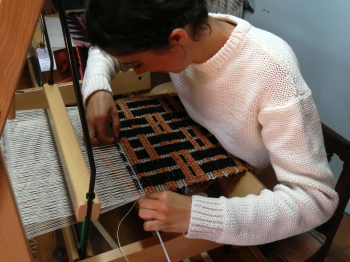 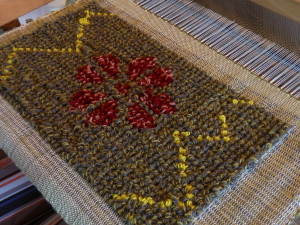 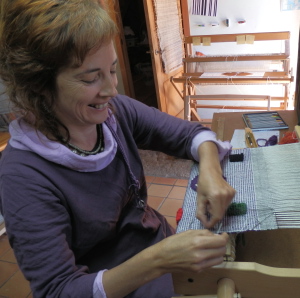 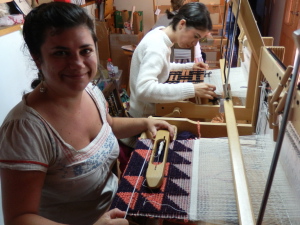 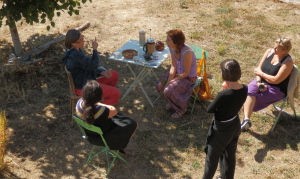 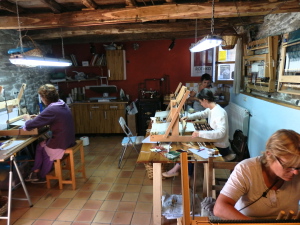
Above: Traditional Galician Spanish textile weaving with Anna Champeney. During the 5-day course pupils learned the back-to-front warping method for preparing Louet looms with a linen warp and then designed and wove their own piece of loop-pile fabric – felpa. Inspiration for the designs included American patchwork quilts from Gees Bend, Galician rag felpa coverlets and simple geometric shapes. During the course pupils used the natural-dyed wools now available online from AC Textile Studio in a range of colours including cochineal (pinks, reds, purples) and yellows (dyers´ chamomile, weld)… You can book either a 2- or 5-day felpa course with expert guidance by Anna Champeney, as part of a craft-based holiday in north Spain at Casa dos Artesans holiday cottage. 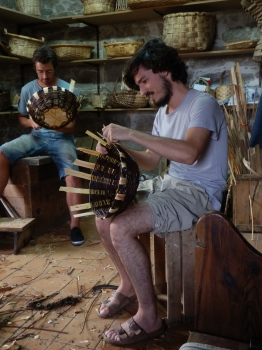
Above: Galician Spanish basketry course with Lluis Grau. You can learn to make this willow and split wood basket in a day of one-to-one tuition, whether or not you have previous basketry experience. 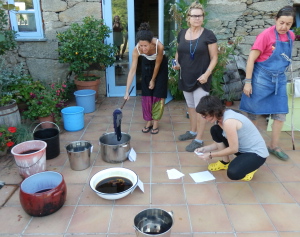 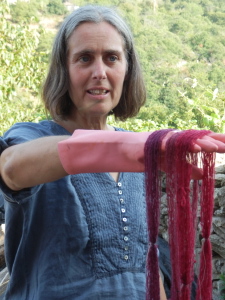 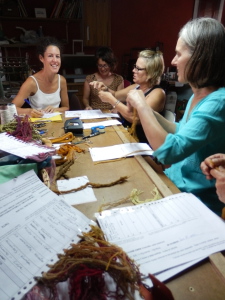
Above: An intensive 2-day course introduced pupils to many of the basic principles of natural dyeing. 5 natural dyes were tested out including the fabulous cochineal from Lanzarote, logwood, oak bark, alder buckthorn bark and onion skins. All pupils took a comprehensive set of samples with them, complete with the recipes to repeat the colours. We can offer our guests one-to-one tuition in natural dyeing which starts at 90€ for a short course. International Textile Conference in Kaunas, Lithuania (September 2011) Anna Champeney will be taking time out of her busy schedule at AC Estudio Textil to travel to Kaunas in Lithuania for the international European Textile Network conference this autumn. Instead of teaching, however, she will be a pupil on the specialist dyeing course with the internationally renowned textile designer and founder of the innovative textile company in Japan, Nuno Corporation – Reiko Sudo. If you are going to the conference this year Anna will be delighted to hear from you if so do make contact! Basketry Fair in Salt, Gerona (Catalunya, Spain), first weekend in October 2011 Come and see us in the international basketry fair in Salt, Gerona. We have a stand, as we do every year, at this fun and friendly fair where you can see and buy baskets from Spain and other European countries. There is also a programme of local music, dancing, and gastronomy. If there is a Spanish basket you particularly like, then commission Lluis now and we can bring the basket along to you at Salt. Galician “piteira” -This traditional chicken nesting basket from north Spain makes an unusual and very snug cat basket 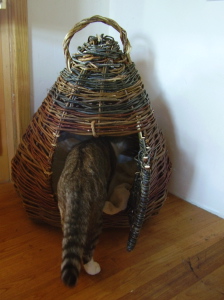 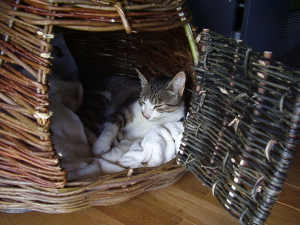 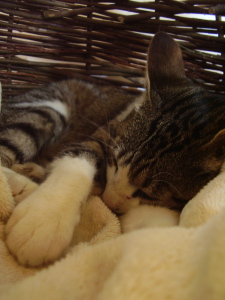
Above: “Pele” investigates the north Spanish Galician piteira basket and gives it the stamp of approval! Lluis Grau, basketmaker, specialises in Spanish basketry forms from the north of Spain and his latest – and very unusual – basket is the piteira or Galician chicken nesting basket. You can order the basket and it can be sent by post (be prepared for a big package to arrive as the basket measures about 65cm H x 55cm W- or you can come for some one-to-one basketry tuition with Lluis and make a piteira yourself on holiday. the cost of the basket varies according to its size but an average size would cost 125€ + postage. We can´t absolutely guarantee your cat or dog will like the basket but we think there is a good chance that he/she will because our cats love it – it took them just 30 seconds to sniff it out and settle in for a first snooze. We call the piteira their “cat palace” – it´s too grand to be called a simple “cat basket”. We think it would be the perfect basket for a cat with kittens as the mother cat is bound to feel more secure in this enclosed basket with a door, that gives her a sense of privacy and protection. The piteira was never made in north Spain for cats, however, but for chickens. It is one of the traditional forms which is now in danger of extinction, and part of our work is to promote a better understanding and appreciation of these wonderful, little known traditional baskets.
  This is no ordinary hand-woven linen cushion for every bucle in this loop-pile fabric has been formed completely by hand – by the weaver´s fingers. The technique of felpa gallega, as it is called, is over 1000 years old and in rural Galicia, in mountainous northwest Spain, this macro-pile fabric is still being made in exactly the same way, on wooden hand-looms, by a new generation of Galician weavers. There is no industrial alternative to an authentic Galician felpa textile – it remains a totally hand-made technique, which is why it is becoming so rare in Spain. This is no ordinary hand-woven linen cushion for every bucle in this loop-pile fabric has been formed completely by hand – by the weaver´s fingers. The technique of felpa gallega, as it is called, is over 1000 years old and in rural Galicia, in mountainous northwest Spain, this macro-pile fabric is still being made in exactly the same way, on wooden hand-looms, by a new generation of Galician weavers. There is no industrial alternative to an authentic Galician felpa textile – it remains a totally hand-made technique, which is why it is becoming so rare in Spain.
How long does it take to make a felpa cushion? An authentic felpa cushion such as this one takes approximately 15 hours to make in total, about 10 of which are spent in forming each of the thousands of bucles by hand. The time involved in making felpa textiles explains why the technique has such a high value and why it is so rare. Modern felpa textiles are not sold via shops, only directly from the weaver´s studio, ensuring best value both for the maker and for the customer. Felpa was traditionally used to make heavy, brightly-coloured and warm bed-covers, colourful “jewels” in the austere stone farmhouses of the Spanish mountain villages and hamlets. Today Anna Champeney Estudio Textil employs the technique to make felpa cushions in both traditional and bold, colourful and contemporary designs. Each cushion, which uses high quality linen and authentic, locally-sourced wool, is made in exactly the same way as centuries ago, with each bucle pulled out of the body of the cloth, by hand. One-off pieces are sold on the internet and directly from the workshop (where you can also spend your holidays in the studio´s holiday cottage, Casa dos Artesans), located in the idyllic Ribeira Sacra, part of north Spain and about 2 hours from the famous pilgrimage city, Santiago de Compostela. The Anna Champeney Textile Studio can also make one-off piecs similar to the one shown, by commission and offers holiday tuition, both for beginners and those with weaving experience. Anna Champeney is able to offer illustrated talks on felpa gallega, based on years of ethnographic research into the technique. This cushion is available for sale and is a one-off, unrepeatable design The cushion has a hand-woven natural linen backing and is fitted with an invisible zip and is supplied with the filler. Hand-wash, without soaking. Inquire about felpa textiles made to order  Felpa Weaving Tuition in Spain Felpa Weaving Tuition in Spain
 galeguiño en felpa gallega, tejido por Anna Champeney Estudio Textil Now and again, in my Spanish (Galicia) folk textile research, I come across hand-woven bed-covers decorated with human figures or animals like the figure shown in this sample which I wove a few days ago. These coverlets use the technique of Galician Felpa (or gorullo), ancient loop-pile weaving technique which is over 1400 years old. It was one of the most common weaving techniques in this northern region of Spain. In 2009 I had the opportunity to examine Galician textiles in the museum stores of the Museo del Traje in Madrid (The Costume Museum). There I found one such coverlet, with not just one or two figures, but a whole collection of dancers and craftsmen, all picked out with Galician felpa, with hundreds of thousands of individual loops. The simple, naieve, childlike figures on felpa coverlets have a special charm of their own. They are, I believe, a very traditional feature of traditional folk textile design in Galicia. In the felpa textiles I weave and sell at my Textile Studio in the Ribeira Sacra in Galicia, I like to incorporate elements of traditional design, especially when I feel they translate well into a modern context. Figures such as these have a naieve charm and appeal that is, in fact, timeless. When I wove the little felpa figure based on the museum coverlet I was aware that I was bringing something that was virtually lost from traditional Galician life and art – and giving it new life again. It is not enough simply to weave these traditional figures into new felpa textiles, however; as Galicians themselves are often unaware of their own textile tradition it is very important to explain what these figures mean. What is the point of having a rich folk art textile tradition if you don´t actually recognise it? It is for this reason, in part, that I give textile talks about the coverlets, write articles, and teach felpa weaving – so the weaving tradition is once again recognised and people can choose a felpa textile as a culturally-significant as well as a beautiful textile. Fixing the technique in tradition and explaining how felpa textiles are made also helps people to understand the price of felpa textiles which is considerably higher than normal textiles. For each individual loop is hand-formed with the weaver´s fingers, not with the shuttle. This means a cushion may take a day and a half to make. Some regions of Spain have lost their traditional textile tradition almost completely. In Galicia there was a very strong peasant weaving tradition but it is still in danger of disappearing completely. There are several weavers, like myself, who still make Galician felpa textiles. The purchase or commission of these textiles in Galicia today is a cultural act full of significance. It is not simply the purchase of a any old cushion or wall-piece, but an expression of identity. In Galicia today more and more people are beginning to place a higher value on tradition. The best way to value a cultural tradition is by keeping it alive. The best way to keep alive an old textile tradition is by supporting the weavers.
|
Pago seguro
 NUEVO Octubre 2023 Curso presencial setmanal de teixits de baix lliç (Girona)!Un curso nou, setmanal (3h) a Sant Gregori, Girona, amb l'Anna Champeney. Trimensual, plaças limitadas).
Octobre 2023. Ven a aprender a diseñar y realizar tejidos en telar de bajo lizo a mano. Docente: Anna Champeney, profesional desde 2004, con marca textil propia, experta en tejido de bajo lizo, docente en la Escola Massana, Barcelona.
 Haga clic aquí para informarte |
















 This is no ordinary hand-woven linen cushion for every bucle in this loop-pile fabric has been formed completely by hand – by the weaver´s fingers. The technique of felpa gallega, as it is called, is over 1000 years old and in rural Galicia, in mountainous northwest Spain, this macro-pile fabric is still being made in exactly the same way, on wooden hand-looms, by a new generation of Galician weavers. There is no industrial alternative to an authentic Galician felpa textile – it remains a totally hand-made technique, which is why it is becoming so rare in Spain.
This is no ordinary hand-woven linen cushion for every bucle in this loop-pile fabric has been formed completely by hand – by the weaver´s fingers. The technique of felpa gallega, as it is called, is over 1000 years old and in rural Galicia, in mountainous northwest Spain, this macro-pile fabric is still being made in exactly the same way, on wooden hand-looms, by a new generation of Galician weavers. There is no industrial alternative to an authentic Galician felpa textile – it remains a totally hand-made technique, which is why it is becoming so rare in Spain.  Felpa Weaving Tuition in Spain
Felpa Weaving Tuition in Spain


